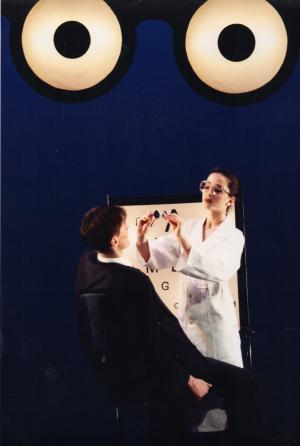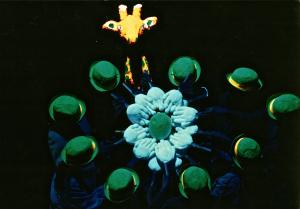The Spectacle (1994)
Duration 25’
For piano and pre-recorded track with Stan Sulzmann (alto sax and jazz Flute) and Liz Kenwood-Herriott (oboe)
Choreography and design: Michael Pink
Studio recording: Ian Gibson
First performed at the Minerva, Chichester as part of the 1994 Ballet Central National tour.
In 1994 Ballet Central saw more of Michael Pink as he spent three months as resident artistic director in London, before returning north to his role as assistant artistic director at Northern Ballet. The Spectacle was the fruit of this period, a surreal and fantastic one act ballet, with a memorable giraffe, a chicken, back-to-back Bavarians and a giant pair of glasses that winked. Appropriately its theme was a visit to the opticians, exploring the altered perception of reality that corrective lenses can often produce.
The music is high-tempoed for much of the time, but is also fundamentally symphonic, despite the disappointing sound of the synthesized strings, the instruments being sourced mainly from the Roland JV 1080. There is a prominent role for sampled timpani which gives the music quite a lot of beef. In the surrealist UV section much play is made of strange pitch bends even of sampled bells and drums.
Ballet Central were fortunate enough to secure the services of jazz saxophonist, Stan Sulzmann, who the composer had worked with on the International Course for Professional Choreographers and Composers at Bretton Hall. He had also helped create the stand-out (or indeed, stand-up) tenor sax solo at the end of Feeney’s music for Derek Williams’ Jazz Concerto (1993) for Northern Ballet Theatre. For the long solo in The Spectacle, this time for alto sax, Sulzmann played along with a guide track in his headphones so that it would synchronise with the rest of the music and would be the correct tempo for the optician’s solo (dancer Chisato Ohno, later of NDT 2 and the Batsheva Dance Company). There was an added complication in that the emergency recording session was held during another perennial drilling of Herbal Hill outside. Extremely close mic-ing was required. There was no such difficulty when Liz Kenwood-Herriott added her habitually exquisite oboe part.
At points the music becomes a piano concerto, particularly in the scherzo, which contained a very effective (and difficult) piano phrase, known as “the Run”; this happens twice, which was fairly masochistic since the composer was also the only ever performer. In that section the second subject is the tune in reverse. The next movement is really a gospel number, that springs quite unobtrusively out of an orchestra tuning-up and goes on to build to a great climax. For the finale, a bucolic swirling waltz, the choreographer replayed the entire piece in three minutes, fast-forwarding in the manner of the Reduced Shakespeare Company.



